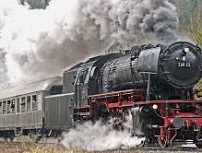 The term locomotive can be used as an adjective or as a noun. In the first case, it refers to that linked to locomotion : the transfer from one place to another.
The term locomotive can be used as an adjective or as a noun. In the first case, it refers to that linked to locomotion : the transfer from one place to another.
Its most common use, however, is as a noun. The machine used to haul the carriages of a train is called a locomotive.
A locomotive is rolling stock since it has wheels and, in this way, can circulate on the tracks . An internal combustion engine, electricity or steam provides the energy necessary to move and drag the formation.
Until the middle of the 20th century and from the beginning of the previous century, steam locomotives were the most used means of railway traction. These machines use the combustion of wood, fuel oil, biomass, coal or other fuel in a boiler, heating water. The steam that arises from boiling allows, thanks to the pressure, to move the pistons that drive the wheels through a set of connecting rods.
A mechanical object that is capable of transmitting movement to articulate other parts of a machine when subjected to compression or traction forces is known as a connecting rod . Steam locomotives had external combustion engines, because they carried out the conversion of heat energy into mechanical energy through a process that took place outside the car.
Since water was essential for the production of steam and, therefore, for the operation of these trains, it had to be replenished with certain frequency . Although at first glance the steam locomotive may seem simply a very distant memory, in some cities they still exist, even if it is only for tourist purposes. The current ones are usually modernized versions of the old ones or models built with advanced technologies but with the appearance of their predecessors.
Diesel locomotives , meanwhile, take advantage of the energy generated by a two- or four-stroke diesel cycle internal combustion engine (two-stroke engines are the most used). Power is transmitted through a mechanical system for smaller trains, but through a hydraulic or electrical system for larger and more powerful ones.
There are also electric locomotives , which receive electricity from an external source. This electrical energy is applied to the traction motor. For its operation, power cables are needed along the entire train route.
 Diesel-hydraulic locomotives and diesel-electric locomotives , meanwhile, combine different components to move and fulfill their function .
Diesel-hydraulic locomotives and diesel-electric locomotives , meanwhile, combine different components to move and fulfill their function .
The diesel-hydraulic locomotive is based on a system of hydraulic turbines that couple together and allow power to reach the wheels gradually from the constantly rotating engine. It is important to note that this system is not capable of moving considerable loads, which is why it is used mostly in automobiles.
Diesel-electric engines, on the other hand, have two components: a certain number of electric motors (called "traction"), which transmit the tractive force to the wheels, and a diesel one, which produces the movement of an electric generator. Typically, a traction motor is placed on each of the axles. These receive electric current from the main generator and then move the wheel axles through pinions.
It should be noted that the idea of a locomotive can be used in a symbolic sense to refer to that which drives something . For example: “Agriculture is the driving force of the local economy” , “Once again, the striker was the driving force of the team” , “Young people must be the driving force of the social and cultural change that this country needs” .
